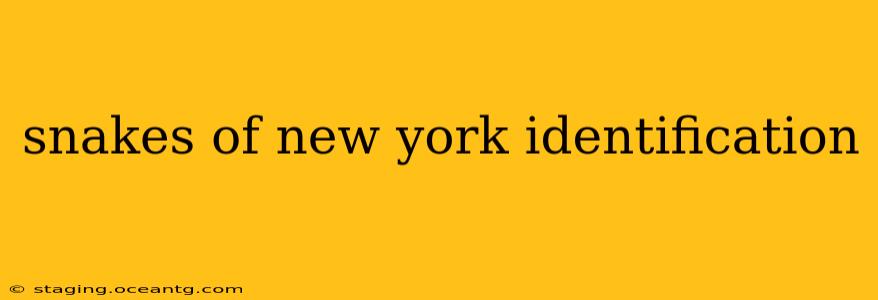New York State boasts a surprisingly diverse population of snakes, ranging from harmless garter snakes to venomous copperheads. Identifying these snakes correctly is crucial for safety and conservation. This guide will help you learn to distinguish between the common species found in the Empire State, addressing some frequently asked questions along the way.
What are the different types of snakes found in New York?
New York is home to a variety of snake species, categorized broadly into venomous and non-venomous types. Non-venomous snakes, the majority, include various species of garter snakes, rat snakes, watersnakes, and others. The venomous snakes are primarily copperheads and timber rattlesnakes, although their populations are considerably smaller and more localized. Accurate identification hinges on paying close attention to key physical characteristics.
How can I identify a snake in New York?
Snake identification requires careful observation and a methodical approach. Consider these key features:
-
Size and Shape: Note the snake's overall length and body shape. Is it slender, robust, or thick-bodied? Look at the head shape – is it triangular (often indicative of venomous species), round, or distinct in some other way?
-
Color and Pattern: The coloration and pattern are paramount for identification. Observe the background color (e.g., brown, gray, green) and any markings – stripes, bands, spots, blotches. Take note of the arrangement of these patterns along the body and tail.
-
Scale Characteristics: While this requires a closer look (perhaps with binoculars), examining the arrangement of scales (e.g., keeled or smooth, size and shape) can significantly aid identification.
-
Location: Where did you see the snake? Different species inhabit different habitats (e.g., woodlands, wetlands, rocky areas). Knowing the location helps narrow down the possibilities.
What is the most common snake in New York?
The most common snake in New York is arguably the Northern Garter Snake (Thamnophis sirtalis sirtalis). These are small to medium-sized snakes, highly variable in coloration but often exhibiting three longitudinal stripes (two dorsolateral and one vertebral) on a background of olive, brown, or black. They're generally found near water sources.
Are there poisonous snakes in New York?
Yes, New York has two venomous snake species: the Copperhead (Agkistrodon contortrix) and the Timber Rattlesnake (Crotalus horridus). Copperheads are smaller, with hourglass-shaped markings along their back. Timber rattlesnakes are larger and have dark brown or black crossbands on a yellowish-brown background. Importantly, both have heat-sensing pits between their eyes and nostrils. Always maintain a safe distance from any snake you suspect is venomous and avoid handling them.
How can I tell the difference between a copperhead and a rat snake?
This is a crucial distinction. Copperheads are venomous, while rat snakes are harmless. Key differences:
- Head Shape: Copperheads have a distinctly triangular head, while rat snakes have a more rounded head.
- Markings: Copperheads have hourglass-shaped markings, while rat snakes often display a pattern of blotches, saddles, or stripes.
- Pupil Shape: Copperheads have elliptical pupils, while rat snakes have round pupils. (Difficult to observe from a distance).
What should I do if I see a snake in New York?
Observe the snake from a safe distance. Try to take a photograph (if you can do so safely) to aid in identification later. Do not approach or attempt to handle it. If you're bitten by a snake, seek immediate medical attention. Most snake bites in New York are from non-venomous species, but it's always best to err on the side of caution.
What resources can help me identify snakes in New York?
Several online resources can aid in snake identification. Check out your state's Department of Environmental Conservation website, which likely offers images and information on local snake species. Field guides are excellent tools, providing detailed descriptions and images.
This guide provides a foundational overview. For precise identification, it's recommended to consult reputable field guides and expert resources. Remember, responsible observation and a respectful distance are key to safe and enjoyable interactions with New York's diverse snake population.
